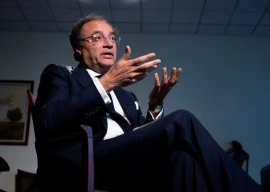
KARACHI: Only two out of an estimated one million graves or tombs have been lucky enough to grab the attention of officials in a campaign to preserve some of Pakistan’s most at-risk treasures. The tombs of Amir Sultan Mohammad and Sultan Ibrahim, located in Makli – the largest necropolis in the world – have been selected for conservation as part of a joint effort by Pakistan and the United States of America, the first of its kind in Sindh.
According to architect Yasmin Lari, the stakes couldn’t be higher for this project. “The conservation of these tombs, which are believed to be 400 years old, will really be a test for any future funding to save Sindh’s rich heritage from decay,” said Lari, who is also the CEO of the Heritage Foundation. On Thursday, an MoU was finally signed between the Heritage Foundation and the Culture, Tourism and Antiquities department of the Sindh government confirming the conservation, which will be funded by the US Ambassador’s Fund for Cultural Preservation (AFCP).
Amir Sultan Mohammad and Sultan Ibrahim, both Turkish in origin, ruled Sindh in the mid-sixteenth century. “The fund of US$260,000 is a meager amount for a project of this scope,” Lari says, “But this is the first time that the AFCP has been convinced to fund a project of this nature in Sindh. The emphasis has previously been on sites in Punjab and Khyber-Pakhtunkhwa.” The AFCP has funded conservation at 18 sites in Punjab and K-P since 2001.
The project includes technical studies of the two sites and damage assessment, as well as meticulous documentation, workshops and training sessions for local artisans in order to encourage their involvement in the restoration work. “The people of these areas used to be well-versed in the creation of pavilion tombs and masonry,” Lari explains, “And we want to revive that cultural art by engaging local communities in the project.”
Makli graveyard was added to UNESCO’s World Heritage List in 1981. Spread over 12 kilometers, the necropolis includes monuments of Samma, Arghun, Tarkhan, Mughal periods. The Heritage Foundation has identified 75 structures, 400 platforms and many graves here that have yet to be dated and surveyed. “Many influential people have started encroaching on this site. We have now finished a demarcation of the graveyard and asked the government to erect a wall around it in order to keep it safe from the land mafia,” Lari said.
However, not everyone is pleased with the project and the intended conservation. “We are happy about the intervention, but I think Jamia Masjid Makli, the tomb of local ruler Jam Nizamuddin, the Maqbara of the sister of Fateh Khan or the tomb of Shaikh Hamad Jamali should have been given priority over these two tombs of Tarkhan rulers,” said archaeologist and former provincial secretary of antiquities Dr Kaleem Lashari. “The structures of those sites have deteriorated greatly. The project will be reviewed at the government’s heritage advisory committee before its implementation,” he added. Others, like Lashari, say the tombs were not selected on the basis of merit as many other historical sites in the country are in a far more vulnerable state.
“We have chosen these tombs because they need multiple works of stone, bricks and kasha (glazed tiles) and our purpose is not limited to conservation but also enhancing the capabilities of local artisans,” Lari responded.
Provincial secretary for culture Aijaz Memon said his department is merely a facilitator in this project. “Ms Lari’s organisation directly submitted the project to the donor organisation,” he said. Meanwhile, Director General Archeology Department Qasim Ali Qasim said that before any work commences, the root cause of the deterioration of these sites must be determined. “Apart from the conservation itself, the capacity building of locals, especially revival of stone-craft techniques, is an excellent idea,” he added.
Published in The Express Tribune, October 17th, 2014.









































1713521455-0/Untitled-design-(9)1713521455-0-270x192.webp)





















COMMENTS
Comments are moderated and generally will be posted if they are on-topic and not abusive.
For more information, please see our Comments FAQ